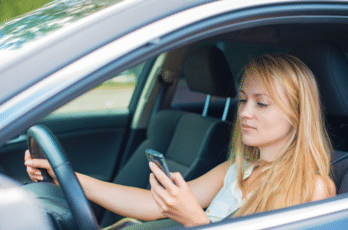
A new device called a textalyzer, designed to reduce the high number of auto accidents caused by distracted drivers, can check to see if drivers have been texting or performing other activities on their cell phones in the moments before a crash.
What is the Textalyzer?
A digital device, called the textalyzer, has been developed to help law enforcement crack down on distracted driving accidents caused by cell phone use behind the wheel. The new textalyzer technology is modeled after the current Breathalyzer device that police use to check a driver’s blood-alcohol level during a sobriety road test. Lawmakers are concerned about the continuing use of cell phones while drivers are on the road. Although talking and texting on a cell phone while driving is illegal in most all states, drivers are still making and receiving calls, texts, and emails while driving. According to law enforcement, this distracted driving behavior is contributing to a high number of car crashes that end in severe injuries and death.
Currently, if an accident occurs police must rely on drivers’ or witnesses’ statements related to suspected cell phone use. If those facts are disputed, the police officer must subpoena cell phone records which is a time-consuming and costly process. To subpoena cell phone records, a warrant that shows probable cause must be submitted to a district attorney and a judge.
With current technology, cell phone records can only detect calls and texts, not internet-based activities like sending and receiving emails, social media posts, streaming music and videos, and Web browsing. With the textalyzer device, police will be able to tap into a driver’s cell phone operating system to check for recent activity. The textalyzer technology can reveal activities including calls, texts, emails, use of social media sites like Facebook and Snapchat, and other cell phone activities that are currently banned.
The textalyzer device is still in development, but once completed it will be easy to use. Police officers will simply attach a cord from the device to the driver’s cell phone. With the tap of one button, the textalyzer will process all recent incoming and outgoing cell phone activities in real time within about 90 seconds. A screen will display a summary of all apps that were opened and/or in use, as well as screen taps and swipes by the phone’s user.
Although lawmakers are convinced that the textalyzer device will significantly reduce distracted driving accidents, the technology has prompted some concerns about privacy issues. The device has raised questions regarding the ability of police officers to access cell phone information of private individuals. Most people keep a lot of personal data on their cell phones including contact numbers, bank accounts, photos, and private texts and emails from employers, fellow workers, family, and friends.
Distracted Driving Accidents
With the explosion of social media sites that boast millions of photos and videos, taking selfies and videos while driving has become a popular past time with many young drivers. Sites like Instagram and Snapchat show thousands of selfies and videos of young teenage drivers talking, singing, posing, primping, and doing a variety of other activities as they drive. According to the National Highway Traffic Safety Administration (NHTSA), teenagers and young adults under the age of 30 are the main offenders of taking selfies and videos while driving. Studies indicate that the main reason given is to share images with friends on social media, a need to multitask, and boredom.
Over the last decade, most states have banned cell phone use while driving. Currently, 46 states along with the District of Columbia, Guam, Puerto Rico, and the US Virgin Islands have laws that ban cell phone calling and texting while driving, and 14 states make it a crime to use any type of hand-held device while behind the wheel.
With strict laws that make cell phone use illegal while driving and numerous public service campaigns that constantly promote safe driving, distracted driving accidents continue to rise in the U.S. According to NHTSA, distracted driving accidents and injuries in 2015 increased by eight percent. In 2016, there were approximately 40,000 traffic fatalities in the U.S., an increase of six percent over 2015. According to law enforcement, many of those fatalities were caused by distracted drivers on their cell phones. NHTSA studies show that thousands of Americans still admit to using their cell phones while driving, even though they know it is against the law and they can receive steep fines and penalties.









